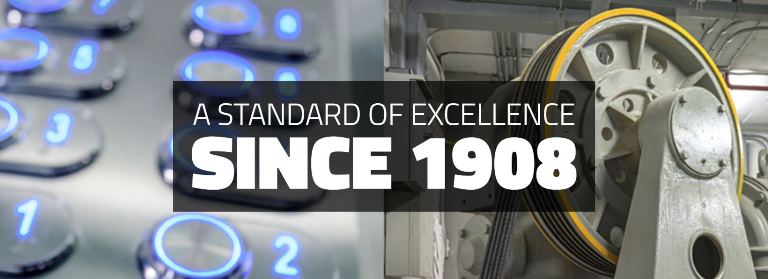I
would like to say thank you for everyone that has been a part of Colley
Elevators 2018, we had a great year! We
have eclipsed out 110th year as an independent elevator company
which is something that everyone past and present should be proud of. Day to day we battle machines, multinational
corporations & strive to educate building owners that there are good
independent elevator contractor options.
This
year we saw our maintenance portfolio grow from 1300 elevators to over
1500. We started an Instagram account
with over 340 followers. We completed
over 75 modernization and new construction projects. We added 2
service/modernization teams. My term as
NAEC president was completed. We have
quite a few new team members getting good experience under their belts. We had a lot of growth over all as a company. I am proud to be a part of this group of
people who are carrying the Colley Elevator torch to year 111. I often say from the person who answers the
phone to the elevator technician who executes and everyone in between, it takes
a team to complete everything we do as a company. I get excited each time our warranty period ends and a building signs a maintenance agreement for the elevator we turned over. That is telling me we are doing a great job from start to finish that the building wants to have a long term relationship with Colley.
Learning
should be an everyday event for everyone. The main goal of the blog is to
provide education and information to colleagues, building owners, consultants
and elevator riders. We had 46 blog
posts, over 2,500 unique views in December[25% above last year] over 24,000
unique views this year, 73,968 since we began in March of 2014.
1/1/18
– Year in review Colley Elevator Blog – 2018 Elevator Blog
1/7/18
- Colley Elevator’s end of year get together
1/14/18
– Hydraulic freight elevator modernization
1/21/18
– NAEC Board of Directors mid year meeting
1/28/18
– Elevator modernization – Village of Carpentersville
2/4/18
– Elevator worker fatalities – Texas & New York
2/11/18
– Elevator maintenance – Building owner cooperation/exterminator
2/18/18
– Rockstar Energy – Elevator World – Craig Zomchek Profile
2/25/18
– CAI HOA Conference – Rosemont, IL
3/3/18
– Elevator modernization Downers Grove Park District – Downers Grove, IL
3/10/18
– Hydraulic elevator cylinder replacement – What we found underground
3/18/18
– Chicago elevator maintenance – Good looking work
3/25/18
– Old elevator controllers – ready for replacement
4/1/18
– City of Chicago Firefighters emergency operation elevator mandate
4/8/18
– Elevator industry consolidation
4/15/18
– Traction elevator modernization – long overdue
4/22/18
– NAEC Spring Conference – Carlsbad California
4/29/18
– Elevator constructor fatality – Columbus, Ohio
5/6/18
– IAEC[International Association of Elevator Consultants] Annual forum
5/13/18
– Proprietary elevator controls Vs. Non-proprietary controls
5/19/18
– Chicago Elevator Association[CEA] – Night at the Races
5/27/18
– Hydraulic elevator modernization – Arlington Heights, IL
6/3/18
– Chicago elevator maintenance, service, modernization & new construction
6/10/18
– Associa Cares – Casino Night 6/8/18
6/17/18
– Water damage in elevator pits
7/1/18
– Hot weather and elevator problems
7/8/18
– Are MRL [Machine room less] elevators dangerous?
7/22/18
– Anatomy of a hydraulic elevator – Borehole elevator cylinder
7/29/18
- Anatomy of a hydraulic elevator – Hole less hydraulic
8/5/18
– Chicago Elevator Association Golf Outing – Quest for the Chicago Cup
8/12/18
- Anatomy of a hydraulic elevator – Cantilever hydraulic elevator
8/20/18
– Traction freight elevator modernization
8/26/18
– GAL Chicago area office opens
9/3/18
– Traction elevator machine room modernization – Chicago, IL
9/9/18
– City of Chicago elevator code requirement/update
9/16/18
– Elevato rhydraluic power unit/pump motor valve replacement – Skokie, IL
9/23/18
– Elevator code changes – A17.1 2016
9/30/18
– NAEC 69th annual convention – Atlantic City
10/7/18
– Hydraulic elevator modernization needed – Skokie, IL
10/13/18
– Elevator door operator & cylinder – Evanston, IL
10/27/18
– How long should and elevator valve last?
11/4/18
– Elevator cylinder failure – deterioration of cylinder metal
11/18/18
– Elevator indpedent service – Get that couch in!
12/9/18
– Elevator fireman’s emergency operation
12/16/18
– Elevator equipment failure – exceeding life expectancy
12/23/18
– Elevator hydraulic fluid filtration/new/valve
12/31/18
- Year in review Colley Elevator Blog – 2019 Elevator Blog
I
would like to thank everyone who has taken their time to read this blog. I will be a broken record from last year;
find your passion and when you look back on the year you will see how much you
have grown professionally, personally and socially. Trade in your selfish for a little selflessness,
it will feel good and you will probably make someone proud they know you. Life is the longest thing we will do but it
is also the most fragile thing we have, do good things, be proud and have a
great 2019!
If
you have any questions or would like additional information feel free to
contact me at CraigZ@colleyelevator.com or
630-766-7230 ext. 107.
Also
check us out on Instagram @Colleyelevator see what we have been up to.










































